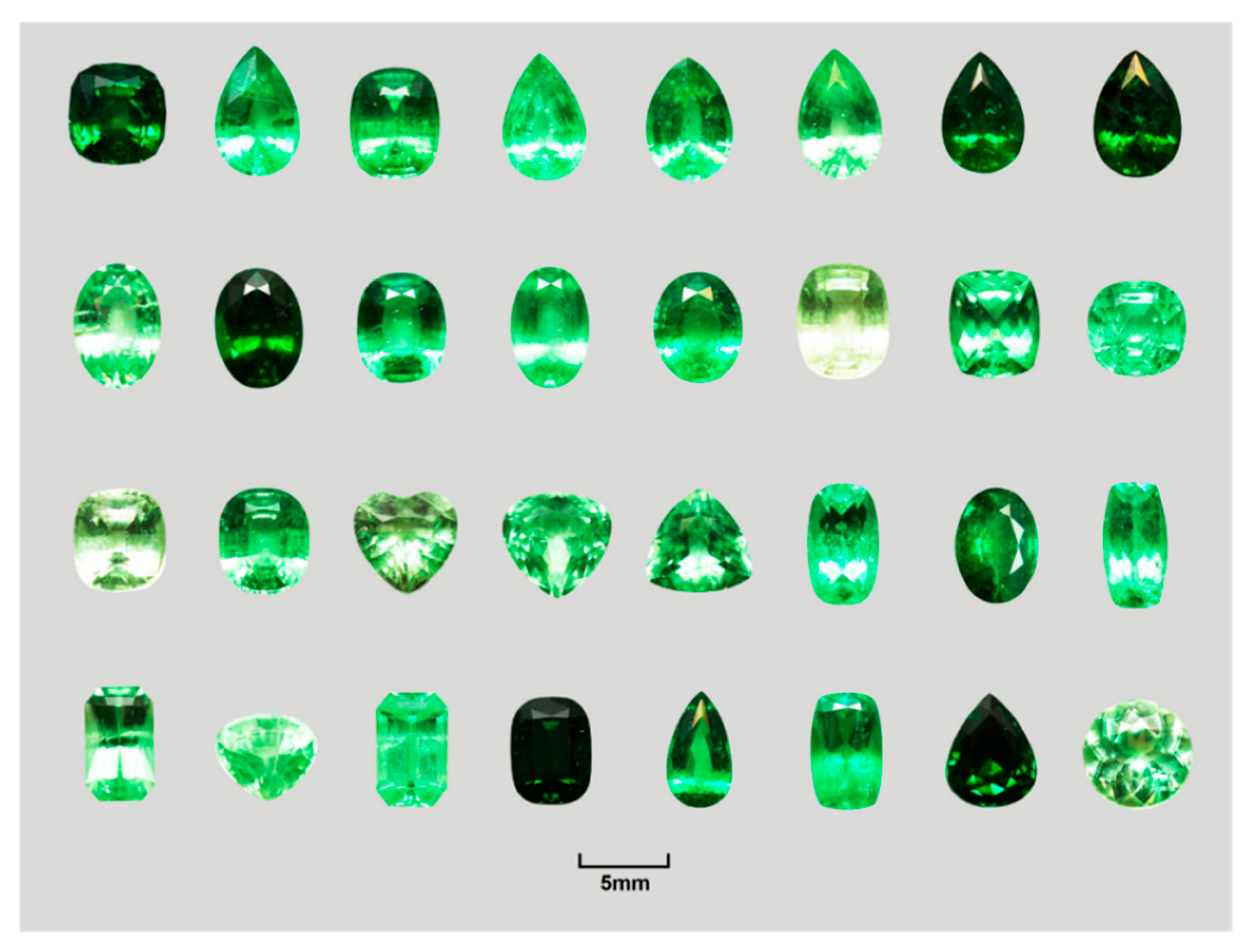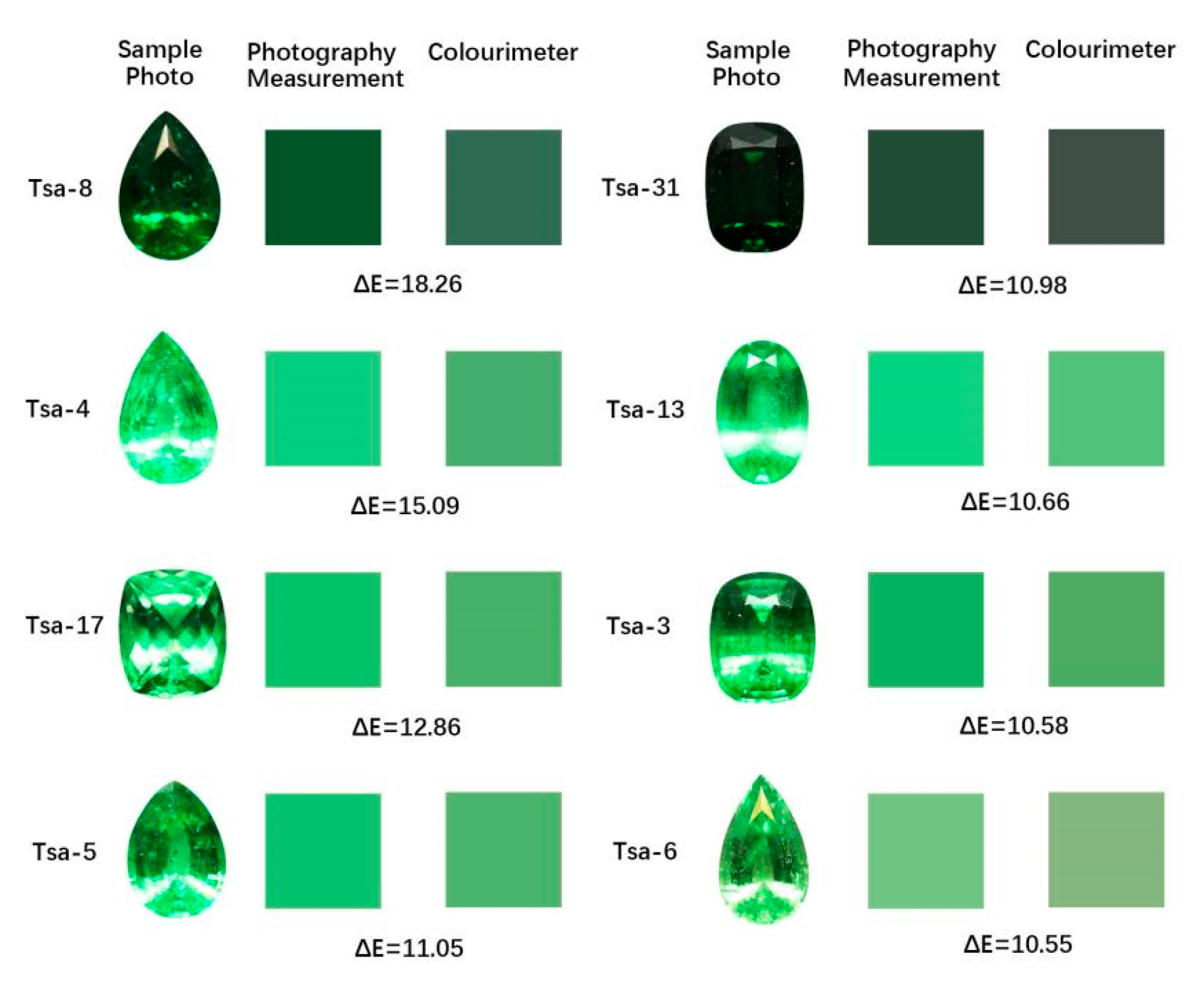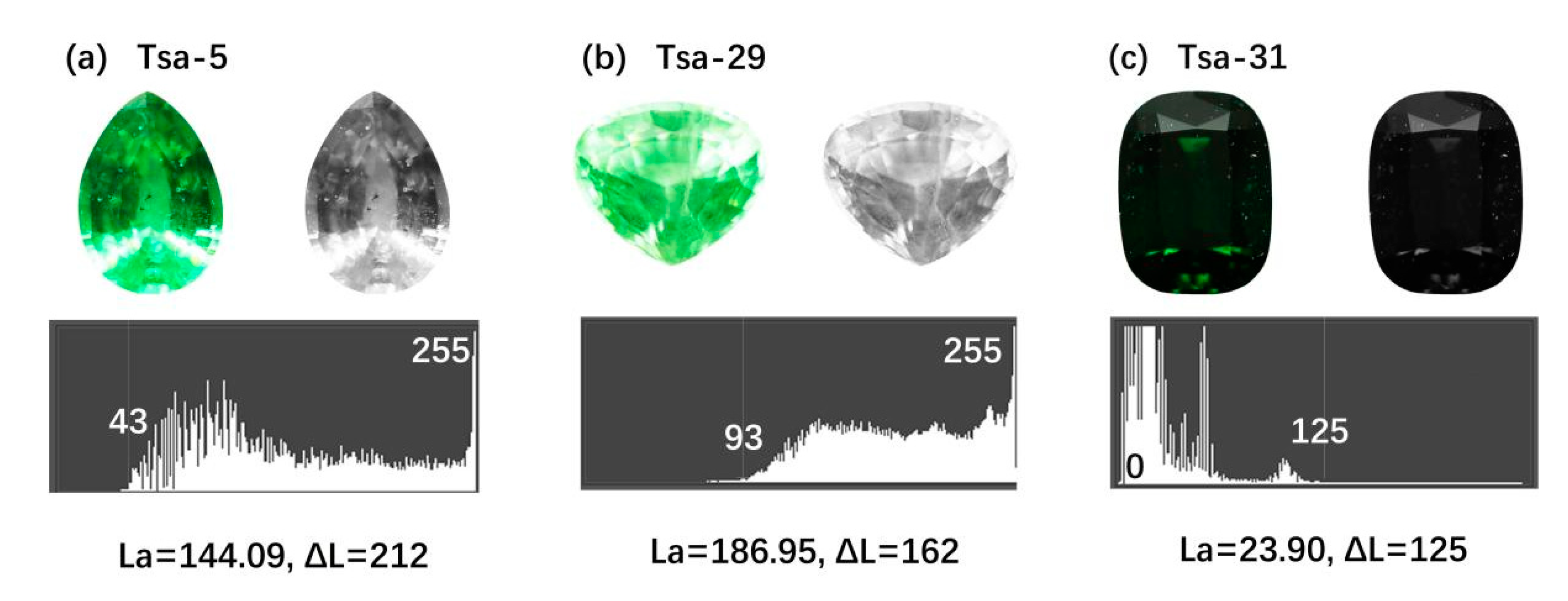The Impact of Munsell Neutral Grey Backgrounds on Tsavorite’s Color and Study on the Evaluation Method of Color Gem Cutting
Abstract
:1. Introduction
2. Materials and Methods
2.1. Samples
2.2. Backgrounds
2.3. Colorimetric Analysis
2.4. CIE1976 Color Space
2.5. Photography Measurements
3. Results
3.1. Effects of the Neutral Grey Backgrounds on Tsavorite Color
3.2. Research on the Feasibility of Photographic Color Extraction
3.2.1. Color-Taking Process
3.2.2. Comparison between the Colorimeter (CM) and Photography Measurement (PM) Results
3.3. The Effect of Cutting Was Studied by Photographic Color Extraction
3.3.1. Color Concentration Improvement
3.3.2. Scintillation
4. Conclusions
Author Contributions
Funding
Institutional Review Board Statement
Informed Consent Statement
Data Availability Statement
Conflicts of Interest
References
- Feneyrol, J.; Giuliani, G.; Ohnenstetter, D.; Le Goff, E.; Malisa, E.P.J.; Saul, M.; Saul, E.; Saul, J.M.; Pardieu, V. Lithostratigraphic and structural controls of ‘tsavorite’ deposits at Lemshuku, Merelani area, Tanzania. Comptes Rendus Geosci. 2010, 342, 778–785. [Google Scholar] [CrossRef]
- Feneyrol, J.; Giuliani, G.; Ohnenstetter, D.; Saul, M.; Saul, E.; Saul, J.M. Le district minier à ‘tsavorite’ de Lemshuku, Tanzanie. Rev. Gemmol. A.F.G. 2010, 172, 11–22. [Google Scholar]
- Feneyrol, J.; Giuliani, G.; Ohnenstetter, D.; Galoisy, L.; Pardieu, V. Is the V/Cr ratio a fingerprint of the geographical origin of ‘tsavorite’ in the Mozambique Belt? In Proceedings of the General Meeting of the International Mineralogical Association: Acta Mineralogica Petrographica, Budapest, Hungary, 21–27 August 2010; p. 776. [Google Scholar]
- Switzer, G.S. Composition of green garnet from Tanzania and Keny. Gems Gemol. 1974, 14, 296–297. [Google Scholar]
- Feneyrol, J.; Giuliani, G.; Ohnenstetter, D.; Fallick, A.; Martelat, J.; Monié, P.; Dubessy, J.; Rollion-Bard, C.; Le Goff, E.; Malisa, E.; et al. New aspects and perspectives on tsavorite deposits. Ore Geol. Rev. 2013, 53, 1–25. [Google Scholar] [CrossRef]
- Ma, Y.; Guo, Y. Variation in Gemological Characteristics in Tsavorites with Different Tones from East Africa. Crystals 2022, 12, 1677. [Google Scholar] [CrossRef]
- Tang, J.; Guo, Y.; Xu, C. Metameric effects on peridot by changing background color. J. Opt. Soc. Am. A 2019, 36, 2030–2039. [Google Scholar] [CrossRef]
- Sun, Z.; Palke, A.; Renfro, N.; Breitzmann, H.; Hand, D.; Muyal, J. Discovery of color-change chrome grossular garnets from Ethiopia. Gems Gemol. 2018, 54, 33–236. [Google Scholar]
- Sun, Z.; Palke, A.C.; Renfro, N. Vanadium- and Chromium-Bearing Pink Pyrope Garnet: Characterization and Quantitative Colorimetric Analysis. Gems Gemol. 2016, 51, 345–369. [Google Scholar] [CrossRef] [Green Version]
- Schmetzer, K.; Bernhardt, H.-J.; Bosshart, G.; Hainschwang, T. color-change garnets from Madagascar: Variation of chemical, spectroscopic and colorimetric properties. J. Gemmol. 2009, 31, 235–282. [Google Scholar] [CrossRef]
- Krzemnicki, M.S.; Hanni, H.; Reusser, E. color change garnets from Madagascar: Comparison of colorimetric with chemical data. J. Gemmol. 2001, 27, 395–408. [Google Scholar] [CrossRef]
- Liu, Y.; Shigley, J.; Halvorsen, A. color hue change of a gem tourmaline from the Umba Valley, Tanzania. J. Gemol. Lond. 1999, 26, 386–396. [Google Scholar]
- Guo, Y. Quality evaluation of tourmaline red based on uniform color space. Clust. Comput. 2017, 20, 3393–3408. [Google Scholar] [CrossRef]
- Han, J.; Guo, Y.; Liu, S. Environmental Issues on Color Quality Evaluation of Blue Sapphire based on GemdialogueTM Col-orComparison Charts. Ekoloji Derg. Ekoloji 2018, 27, 1365–1376. [Google Scholar]
- Liu, Y.; Shigley, J.; Fritsch, E.; Hemphill, S. The “alexandrite effect” in gemstones. Color Res. Appl. 1994, 19, 186–191. [Google Scholar] [CrossRef]
- Tang, J.; Guo, Y.; Xu, C. Light pollution effects of illuminance on yellowish green forsterite color under CIE standard light source D65. Ekoloji 2018, 27, 1181–1190. [Google Scholar]
- Sun, Z.; Renfro, N.; Palke, A.C. Tri-color-change holmium-doped synthetic CZ. Gems Gemol. 2017, 53, 259–260. [Google Scholar]
- Liu, Y.; Shi, G.; Wang, S. Color Phenomena of Blue Amber. Gems Gemol. 2014, 50, 2–8. [Google Scholar] [CrossRef]
- Guo, Y.; Wang, H.; Du, H. The foundation of a color-chip evaluation system of jadeite-jade green with color difference control of medical device. Multimed. Tools Appl. 2016, 75, 14491–14502. [Google Scholar] [CrossRef]
- Guo, Y.; Wang, H.; Li, X.; Dong, S. Metamerism appreciation of jadeite-jade green under the standard light sources D65, A and CWF. Acta Geol. Sin. Engl. Ed. 2016, 90, 2097–2103. [Google Scholar] [CrossRef]
- Guo, Y. Quality grading system of Jadeite-Jade green based on three colorimetric parameters under CIE standard light sources D-65, CWF and A. Bulg. Chem. Commun. 2017, 49, 961–968. [Google Scholar]
- Guo, Y.; Zong, X.; Qi, M. Feasibility study on quality evaluation of Jadeite-jade color green based on GemDialogue color chip. Multimedia Tools Appl. 2018, 78, 841–856. [Google Scholar] [CrossRef]
- Guo, Y.; Zong, X.; Qi, M.; Zhang, Y.; Wang, H. Feasibility study on color evaluation of jadeite based on GemDialogue color chip images. EURASIP J. Image Video Process. 2018, 2018, 95. [Google Scholar] [CrossRef] [Green Version]
- Guo, Y.; Zhang, X.; Li, X.; Zhang, Y. Quantitative characterization appreciation of golden citrine golden by the irradiation of [FeO4]4−. Arab. J. Chem. 2018, 11, 918–923. [Google Scholar]
- Cheng, R.; Guo, Y. Study on the effect of heat treatment on amethyst color and the cause of coloration. Sci. Rep. 2020, 10, 14927. [Google Scholar] [CrossRef] [PubMed]
- ISO/CIE 11664-4:2019(E); Colorimetry—Part 4: CIE 1976 L*a*b* Colour Space. ISO: Geneva, Switzerland; CIE: Vienna, Austria, 2019.
- Lam, Y.-M.; Xin, J.H. Evaluation of the quality of different D65 simulators for visual assessment. Color Res. Appl. 2002, 27, 243–251. [Google Scholar] [CrossRef]
- Liao, N.F.; Shi, J.S.; Wu, W.M. An Introduction to Digital Color Management System; Beijing Institute of Technology Press: Beijing, China, 2009; p. 47. [Google Scholar]
















| Contrast the Obverse and Reverse Sides of a Stone without the Fire Color (Figure 9 Left) | Contrast the Obverse Side of a Gem with or without the Fire Color (Figure 9 Right) | |
|---|---|---|
| Average of |ΔL| | 6.15 | 4.41 |
| Average of |ΔC| | 6.26 | 4.56 |
| Average of |Δh| | 1.11 | 1.46 |
| Average of |ΔE| | 9.53 | 6.93 |
| Number of samples optimized for both L and C | 23 | 5 |
| Number of samples optimized for L or C | 6 | 16 |
| Number of samples with both parameters not optimized | 6 | 8 |
Disclaimer/Publisher’s Note: The statements, opinions and data contained in all publications are solely those of the individual author(s) and contributor(s) and not of MDPI and/or the editor(s). MDPI and/or the editor(s) disclaim responsibility for any injury to people or property resulting from any ideas, methods, instructions or products referred to in the content. |
© 2023 by the authors. Licensee MDPI, Basel, Switzerland. This article is an open access article distributed under the terms and conditions of the Creative Commons Attribution (CC BY) license (https://creativecommons.org/licenses/by/4.0/).
Share and Cite
Ma, Y.; Guo, Y. The Impact of Munsell Neutral Grey Backgrounds on Tsavorite’s Color and Study on the Evaluation Method of Color Gem Cutting. Appl. Sci. 2023, 13, 1673. https://doi.org/10.3390/app13031673
Ma Y, Guo Y. The Impact of Munsell Neutral Grey Backgrounds on Tsavorite’s Color and Study on the Evaluation Method of Color Gem Cutting. Applied Sciences. 2023; 13(3):1673. https://doi.org/10.3390/app13031673
Chicago/Turabian StyleMa, Yuanmeng, and Ying Guo. 2023. "The Impact of Munsell Neutral Grey Backgrounds on Tsavorite’s Color and Study on the Evaluation Method of Color Gem Cutting" Applied Sciences 13, no. 3: 1673. https://doi.org/10.3390/app13031673






